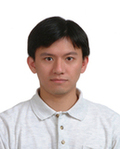Visiting Researchers
 |
Institute |
Institute of Earth Sciences, Academia Sinica |
Title |
Post Doctoral Fellow | |
Country |
Taiwan | |
Period of Stay |
2007/04/01 - 2007/09/28 | |
Research Theme |
Crustal and upper mantle structure of Taiwan | |
Host Researcher |
Naoshi HIRATA |
Hello, Everybody. My name is Chien-Ping Lee. I am a seismologist from Taiwan. My research interests include studies of subsurface structures from results of earthquake location and focal mechanism, the spatial and temporal variations of seismic data before and after large earthquakes, and analysis of nonlinear site effect from downhole accelerometer array data. It is my pleasure to visit Earthquake Research Institute, University of Tokyo for 6 months. During the stay, I work with Prof. Naoshi Hirata to study seismic attenuation under eastern Central Mountain Range in Taiwan. In order to find out the possible causes of the aseismic zone under eastern Central Mountain Range a dataset of linear array across south Taiwan is used. I also would like to learn from others at ERI. It is a good opportunity for me to work and cooperate with researchers at ERI during this period.
I stayed at ERI from 1 April 2007 to 28 September 2007. During this period, I studied the topic about attenuation structures under Eastern Central Mountain Range in Taiwan. I cooperate with Professor Naoshi Hirata for the studies. There is an aseismic zone in eastern central Taiwan. In order to investigate the characteristics in the area, we use the seismic data which recorded by seismic linear array across southern Taiwan. We picked P wave and S wave arrival times first. Then we fitted the seismic spectra to obtain the parameter of attenuation by using theoretical source model. From the observed results we can infer the low Q area which exists in the study area. At last, we did attenuation tomography in the central part of Taiwan. We found that the low Q areas exist under eastern Central Mountain Range. It might be related to aseismic zone in eastern Central Mountain Range. We will compare the results with other geophysical data. The results of the study will be written in a paper soon.
There are many seminars at ERI every month. I attended some of them. I also presented two talks at ERI. One is in Fukinshitsu seminar. I presented the study of microearthquakes and active faults in Northwestern Taiwan. The relocated events are shifted toward northwest in the horizontal direction and become clustered at depth from 5 to 10 km. The results of relocation are consistent with the variations in geology from northwest to southeast in the study area. The other is in Danwakai seminar. The content of my talk is about the variations of P-wave travel-time residuals before and after 1999 Chi-Chi, Taiwan earthquake. The results show that travel-time residuals change in an anomalous zone which occurred about six years before Chi-Chi earthquake. It means the velocity structures change before the Chi-Chi earthquake. The method can be used to monitor and identify variations of P-wave travel-time residuals which may be precursors to a large earthquake.
Chuetsu-Oki earthquake occurred in Japan on 16 July 2007. I got a chance to deploy the temporary seismic network with Drs. Aitaro Kato, Eiji Kurashimo, and others at ERI. We went to Niigataken to deploy 40 seismic stations in 3 days. There is a lot of liquefaction around the source area. Many houses collapsed and earth cracked due to strong shaking. It’s a special experience for me to participate in field work in Japan.
During my stay, I made many friends and learned many things at ERI. I appreciated my host Professor Naoshi Hirata. He suggested and encouraged me about the study. I learned a lot from the discussions. I thank Professor Teruyuki Kato and Ms. Tokie Watanabe in International Office of ERI. They help me many things when I stay at ERI. Drs. Aitaro Kato, Eiji Kurashimo, Ogawa.Tsutomu, Haeng Yoong Kim, Shigeki Nakagawa and other members at ERI help me in this period. I also thank Professor Shuhei Okubo, the director of ERI, who introduce me to Japanese Culture. It is a fruitful trip for me. I appreciate the opportunity to stay at ERI for six months.
